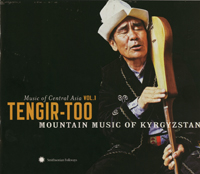
TENGIR-TOO
MOUNTAIN MUSIC OF KYRGYZSTAN (Smithsonian Folkways SFW CD 40520)
The more you listen to music the more it all sounds connected. The Uighurs are not that far removed from the Weavers. I put this latest Smithsonian Folkways disc on expecting to find it weird but instead started thinking about the Kinks. The Kinks had a distinctive sound. They weren't that good when they started but kept hammering away at two then three chords in endless variations until they had a series of hits & a recognizable signature sound. Now, hearkening back, you can tell their influences, identify American R&B songs they were copping. Tengir-too, a bunch of Kyrgyz rockers wear tall white felt hats (like the Kinks in their Mod red velvet jackets) and they also work out variations on a number of riffs that don't seem too far, via Asia, from 12-bar blues. I felt so immediately at home in this music I was surprised. The komuz is the most familiar sound on here. It's a three-stringed fretless lute like the molo of Mali or guimbri of Morroco. Nurak Abdrakhmanov not only plays a mean komuz, he makes them too. "Attila Khan," which he performs, reminds me obliquely of "Memphis" by Chuck Berry, while the intro recalls the classic walking fifth/sixth/flatted seventh 12-bar riff that resonated from the Ad Libs' Do-wop hit "Talk about the boy from New York City" to Ray Charles' "Wha'd I say?" (Or from the Monkees' "Last Train to Clarksville" to the Kinks' "Well-respected man.") I was going to push my luck and say that his other contribution, "Kambarkan," sounds like "Dedicated follower of fashion," but feel my credibility slipping! But I do think the opening flute on "Kyiylyp turam" could be Venezuelan. Tenger-Too's music is nomadic rather than urban, and shifts and evolves making it both contemporary and traditional. Though it is rooted in the traditional those traditions were swept under the rug by the Bolshevik Revolution in 1917 that tried to organize them. They are up against the Celestial Mountains of China's far west and surrounded by the -Stans (Kazakh, Uzbeki, Turkmeni, Afghani, Tajiki, Paki and Filmistan, or India). There's a lavish 48-page booklet and a DVD of the performance included in this package, which was bankrolled by the Aga Khan Trust for Culture. The producers have found the ideal model in Tengir-Too. Dedicated to preserving their cultural heritage, they teach musical notation, but also teach improvisation by mimicry to children, so the music will continue to evolve.

THE KYRGYZ PEOPLE OF CENTRAL ASIA
SHÜÜDÜNGÜT'S ROAD (kyrgyz music).
You can get pretty far out into the world to places you would think were untainted by Western influences and the music will still remind you of something familiar, like the blues. That's what I thought when I put on SHÜÜDÜNGÜT'S ROAD (Music of the Kyrgyz People of Central Asia). This is one to sample in small bites. As a deejay you can drop a track into a set but I can't play the whole thing through. However it is useful as a historical compendium of the post-Soviet music that still has traces of earlier Mongol and Persian influences and anyone who has been lost on the Silk Road will probably adore it. A stringed instrument, the banjo-like komuz, appears frequently including on a speedy march played by an ensemble of 14 children. There's a shot of them in their traditional costumes and the note "When you hear them shout 'OPA!' they are playing over the shoulder." This is followed by a wacky version of Mozart's "Turkish March" on solo komuz and then a mouth harp solo on jigatch, considered the most ancient Kyrgyz instrument. The fiddle-like kyl kiak is also heard. The biggest pop star in the region, Salamat, does one number twice: once with her komuz and once with synthesizer (this latter version sucks, in my opinion). The clean version with komuz has a much greater delicacy and she sings it with a lot more feeling.